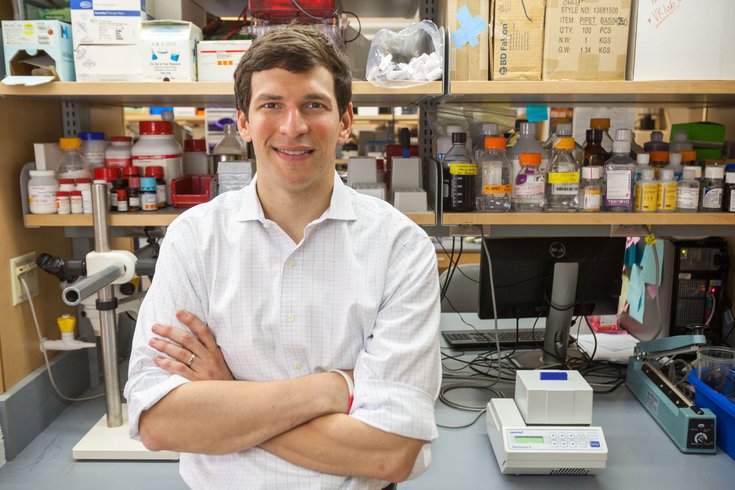
June 01, 2020
 Thom Carroll/PhillyVoice
Thom Carroll/PhillyVoice
Dr. David Fajgenbaum, above in 2015, has led Penn Medicine's efforts to create a database of every off-label and experimental drug being used to treat COVID-19.
Dr. David Fajgenbaum has spent much of the last decade searching for a cure for his own rare disease.
The Penn Medicine immunologist has slowed that pursuit in recent months to join the worldwide effort to identify a treatment for COVID-19.
He's shifting gears partly because his own disease, idiopathic multicentric Castleman disease, and COVID-19 cause a similar cellular response. But he also recognizes that rare disease researchers have some valuable insight to offer amid the coronavirus pandemic.
"When you study rare diseases, you have two problems," Fajgenbaum said. "You have a rare population and you almost always have a poorly understood disease, a disease where there are a bunch of holes in our knowledge. Right now with COVID-19, it's a disease that's common – a lot of people have it. But it's very poorly understood.
"You never want to be in a data-free zone, but COVID-19 has sort of created this situation (that) us in rare disease research are very used to."
Fajgenbaum and his research team have created a database tracking every off-label and experimental drug being used to treat COVID-19 patients. Their hope is the open-source inventory, dubbed the COvid19 Registry of Off-label & New Agents, will help researchers identify treatments that deserve to be more fully examined in clinical trials.
That could lead to an existing drug being repurposed for COVID-19.
"We can develop (new treatments) for COVID-19, but that's going to take years," Fajgenbaum said. "We don't have time to wait. ... If you are going to repurpose, you have to really track what's being given, what's not being given and try to get a sense for what's working and what's not working."
Fajgenbaum understands how critical an off-use drug can be. He failed to respond to the available treatment options for Castleman disease, nearly dying from the immune system disorder. But through his research efforts, he identified a drug that had off-label potential.
In consultation with his physician, Fajgenbaum tested the drug on himself and has been in remission for several years.
The drug, sirolimus, had been available at pharmacies for years. Fajgenbaum suspects a treatment for COVID-19 already may exist, too. That's why he took it upon himself to catalog the various drugs being used against COVID-19.
"I was just thinking, 'I hope some research lab out there will look at all the FDA-approved drugs to systematically evaluate what could be repurposed against COVID-19, to track when drugs are actually repurposed against COVID-19,'" Fajgenbaum said.
"Then I had a minute or two to think. I was like wait a minute. Why would I just hope that someone else just does this? We've spent the last eight years studying cytokine storms, studying drug repurposing. Yes, Castleman disease is our priority and our focus. But there are ways that we can redirect some of that focus toward COVID-19."
Fajgenbaum's team has reviewed nearly 2,700 published papers and analyzed data on 9,152 patients treated for COVID-19. At least 115 drugs have been used. The researchers' findings were published in Infectious Diseases.
Antivirals are the most common type of treatments being administered, according to their database. Lopinavir/ritonavir, a drug combination approved to treat HIV, has been the most frequently used treatment. Antibacterials, corticosteroids, immunosuppressants and blood substitutes also are being used.
Tracking the drugs is the easy part, Fajgenbaum said. Determining which drugs have the most potential will be more difficult, because many of them are being used without control groups.
"If you study a disease like Castleman disease, where no one gets better without treatment, then any time you do a trial and you give people a treatment and they get better, you can say it's the drug that works," Fajgenbaum said. "COVID-19 is not like that. Most people get better regardless of whether they receive treatment.
"What that means is that all these trials that are single-arm, where they only give patients the drug and there's no control group – it makes it really hard to interpret. How much is it the drug versus how much is it that that patient was going to get better anyway?"
There is considerable overlap between the immune system responses of Castleman disease patients and those battling severe COVID-19 cases, Fajgenbaum said. Both cause cytokine storms – when the immune system becomes hyperactive, leading to life-threatening complications.
One particular cytokine, Interleukin 6, particularly becomes hyperactive in Castleman disease patients. It also appears to play a critical role in COVID-19, Fajgenbaum said.
"When I say critical, I mean in the most deadly cases," Fajgenbaum said. "In the patients that are mildly symptomatic, they don't have elevated IL6. They don't end up in the ICU. It's the patients that are most sick that develop what we call a cytokine storm, which is basically where you have a hyper-activated immune systems that causes tons and tons of cytokines to be produced, which leads to this organ disfunction."
That makes finding drugs that can control a cytokine storm imperative.
Fajgenbaum has experience searching for such treatments. But his own experiences as a patient with a life-threatening, rare disease provide him with a unique outlook. He has written a book about how living with uncertainty has shaped his life and research efforts.
"I think COVID-19 has almost created a sense of overtime for many of us," Fajgenbaum said. "The clock is ticking for ourselves and our loved ones. That can create a lot of fear, so trying to turn some of that fear into clarity is what's important. That's something else I've been trying to share."